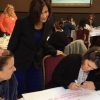Using art as a pedagogical tool in teaching math, science and other subjects—known as arts integration—is showing promise for enabling low-performing students to learn and retain academic content, asserted Vice Dean Mariale Hardiman at a conference in Valencia, Spain, on Mobile Brain-Body Imaging and the Neuroscience of Art, Innovation and Creativity.
In her presentation, “How Can the Arts and Neuroscience Describe and Promote the Processes of Learning and Creativity in K-12 and Higher Education?,” she explained that participation in the arts should become a central component of schooling since research suggests that it can be a significant factor in improving academic outcomes.
To expand on a growing body of correlational research, Hardiman and her research team at the Johns Hopkins School of Education conducted randomized control trials to test the efficacy of arts-integrated science units compared with conventional science units. They designed treatment and control units using the same science content, and designed arts activities that would require the same amount of teaching time as in conventional lessons.
Delayed post-tests results showed an advantage for arts-integrated teaching for students’ long-term retention of science content. That increase in retention in the arts-integrated units was especially strong for students at the lowest levels of reading achievement.
“We believe that the arts provide another vehicle for students with limited language or lower academic skills to demonstrate mastery of academic content,” said Hardiman.
The conference, sponsored by the University of Houston’s Cullen College of Engineering, attracted artists, scientists, engineers, medical professionals, educators and technologists who discussed ways of developing methods for how brain activity can be measured as it relates to emotions, aesthetics, innovation, sensory experiences, STEAM education and art therapy.
“My interest is in memory—the instructional strategies that help children remember information more effectively,” she said. “Research suggests that students retain only about 50 percent of what they’ve been taught after one to two years.”
She said her team’s studies provide some preliminary causal connections between arts-integrated learning and memory for content, and that the findings also raise some interesting questions about whether learning through the arts transfers residual benefits, such as increased engagement in learning tasks and general thinking dispositions.
“We observed that students who experienced the arts-integrated units first performed significantly better in subsequent conventional units compared with students who had not yet experienced the arts-integrated units,” she said. “That made us wonder if students who were taught using arts-integrated instruction may have later applied arts-based strategies, even when not taught through the arts.”
Hardiman and her colleagues Amy Shelton, associate dean for research; Jonathan Plucker, the Julian C. Stanley Endowed Professor of Talent Development; Stephen Pape, professor of education; and Ranjini JohnBull, assistant professor of education, have submitted a $3 million grant proposal to the Institute for Education Sciences to explore “The Effects of Arts-Integrated Instruction on Students’ Retention of Content, Creative Problem Solving, and Arts Skills and Conceptual Competencies.”
“Through the Neuro-Education Initiative and our collaborations with the Science of Learning, we’re exploring research that can help educators understand how students learn and how findings can inform instructional practice,” said Hardiman. “What’s the most effective pedagogy for imparting content, skills and concepts that students need to know and then apply in creative problem-solving tasks? If the arts can be an answer to that, it’s worth researching.”

